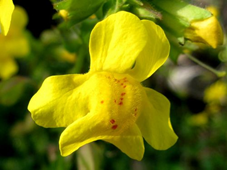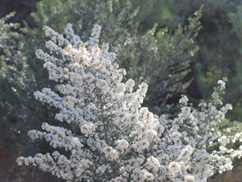GOING WILD WITH NATIVES: Monkeys, Deer, & Snowflakes - Perfect California Natives For Your Garden!
- k-england
- Feb 1, 2022
- 4 min read
Updated: Jun 21, 2022
By Susan Lewitt, for Let's Talk Plants! February 2022.

What is the best way to add exciting diversity to your garden? Using an assortment of California native plants with different characteristics will help give your garden appeal. The following plants vary in size, and texture, and are among the easiest to raise in your garden.
Seep Monkey Flower, Erythranthe guttata, formerly known as Mimulus guttatus, is a flowering herb, that grows about 2’ tall (but can climb higher if given support) and about 6” wide, and shows off its yellow vibrant flowers winter through spring. It grows in most of California, especially in Pacific Ocean splash zones, Yellowstone National Park Geysers, alpine meadows, serpentine barrens, and copper mine areas. It may also be found floating in small bodies of water. Both annual and perennial forms can be found in all those areas.
Although this Monkey Flower species requires a once-a-week watering during the summer once established, that is far less than many non-native species requiring water 3 or more times a week. It will do very well in a riparian area or even in or by a pond. It prefers soil that is moderately to highly moist with slow drainage or standing water. Extra water allows it to grow even faster. It is a very easy-to-care-for plant, accepting partial shade to full sun, and temperatures down to -15° F. It is fast growing and will produce seedlings. Periodic trimming or removal will keep this prolific plant in check.
Hummingbirds love this plant which makes it great for hummingbird gardens, as well as bird, bee, and butterfly gardens. It is host to pollinators including possibly some Checkerspot butterflies. It is deer resistant and can be used in bogs and ponds. Other moist soil loving plants that will grow with it include Scarlet Monkeyflower, Erythranthe cardinalis, Stream Orchid, Epipactis gigantea, Hedge Nettle, Stachys bullata, and various Carex and Juncus species.
White Coast Ceanothus, Ceanothus verrucosus, an evergreen shrub with small snow-white, black, or cream-colored flowers grows up to 10’ tall by 8’wide. It can be found growing wild in natural areas all over San Diego County and all the way north past Oceanside. It grows in dry hills, mesa canyons, marine terraces, coastal bluffs, and a limited subtype of chaparral known as southern maritime chaparral that has sandstone soil. The flowers which appear from winter through spring, have a slight fragrance.
It grows in full sun with fast to medium draining soil that is low in moisture. It is okay with temperatures down to 30° F. Once established, once-monthly watering will suffice. It is an easy-care plant that can be pruned as needed. This plant has several garden uses such as hedges, and bank stabilization. It is deer resistant and works well in butterfly, bird, and bee gardens. It may attract many pollinators including the Grey Hairstreak and Pale Tiger Swallowtail butterflies. The following are companion plants that grow well with it: Laurel Sumac, Black Sage, Woolyleaf Ceanothus, Torrey Pine, Del Mar Manzanita, Summer Holly, Chamise, San Diego Sage, Encinitas Baccharis, Del Mar Mesa Sand Aster, Nuttall's Scrub Oak, and Bushrue.

Deergrass, Muhlenbergia rigens, is a versatile and very easy to grow native grass that can be found from our border with Mexico, all the way north past San Francisco, mainly in coastal ranges of central and southern California, the Cascade foothills, and the eastern part of the Northern Coast range. It grows in many different environments including grasslands, riparian, chaparral, mixed conifer, and oak woodland communities.
This plant works well with larger shrubs, like Toyon, Heteromeles arbutifolia, Lemonade Berry, Rhus integrifolia, larger Ceanothus species, Manzanita species, or Scrub Oaks. It can be a ground cover and is deer resistant. Ladybugs and butterflies use this grass for winter hibernation. Its deep roots make it ideal for bank stabilization. Like the White Coast Ceanothus, it likes full sun, low moisture soil and watering once monthly once established. It will grow in soil types ranging from fast to slow drainage.
Native Americans used this grass for basket making. Fire was used to ensure this grass grew the long straight shoots required for their baskets, which took 3,000 shoots each. Deergrass helps displace exotic plants when it is used to restore wild areas. It can also be used to recondition farmland that has been tilled too much and is eroded. It acts as an anchor to add back organic matter and sequester carbon into the soil. Overgrazing of Deergrass leads to fewer fawns because this plant is their ideal hiding place.
There are over 700 native plants that grow in San Diego including 84 very-easy-to-grow species. With such great variety, it is easy to landscape your property with beautifully varied native flora such as the three covered in this article. This way your garden will be part of the solution supporting San Diego’s biodiversity and its designation as a biodiversity hotspot.
Sources:
Calscape, https://calscape.org
I Naturalist: Deergrass, https://www.inaturalist.org/guide_taxa/1593534







